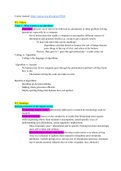Class notes
7 weeks of readings + lecture notes for Topic Algorithmic Persuasion in the Digital Society
- Course
- Institution
This document contains all the lecture notes from the course Topic Algorithm in the Digital Society and all the reading notes. It includes all the names of the articles and their authors the articles are the following: 1. Zarouali, B., Boerman, S.C., Voorveld, H.A.M., & Van Noort, G. (2022). The ...
[Show more]



